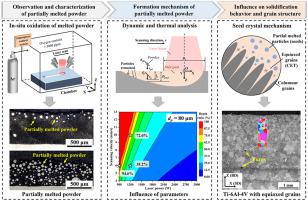International Journal of Machine Tools and Manufacture ( IF 14.0 ) Pub Date : 2023-08-18 , DOI: 10.1016/j.ijmachtools.2023.104072 Wei Fan , Yijie Peng , Yang Qi , Hua Tan , Zhe Feng , Yongxia Wang , Fengying Zhang , Xin Lin

|
The powder–melt pool interaction behavior is crucial in laser-based directed energy deposition (LDED). Partially melted particles, which are formed as a result of this interaction, significantly influence on the microstructure and mechanical performance of multi-material and metal-matrix composites fabricated via LDED. However, the presence of partially melted particles is a contentious issue that has been overlooked in single-material LDED studies. Furthermore, the investigation of partially melted particles is hindered by the difficulties in direct observation. To overcome this obstacle, this study was conducted using a single-bead Ti–6Al–4V printing experiment with a relatively high oxygen content to distinguish partially melted particles directly. The formation mechanism of the partially melted particles was revealed through experimental studies combined with numerical analysis using a self-established model. Additionally, the influence of partially melted particles on the grain structure of LDED–fabricated parts was investigated in a low–oxygen environment. The partially melted particles tend to survive close to the surface of the deposited layer. As the penetration depth increased, the particle size decreased and the aspect ratio increased. The formation of partially melted particles collectively depends on the laser power, scanning velocity, powder size and powder feed speed, differing from the common conclusion that an insufficient input energy results in poor powder melting behavior. Furthermore, a Ti–6Al–4V sample with high–fraction equiaxed grains was fabricated using optimized processing conditions. The partially melted particles significantly affected the solidification behavior. In addition to the heterogeneous nucleation mechanism caused by the partially melted particles, a novel seed crystal mechanism was proposed to support the abnormal formation of equiaxed grains. This study highlights the importance of partially melted particles in LDED, and provides useful insights into in-situ microstructural control in LDED.
中文翻译:

激光定向能量沉积中部分熔化粉末:形成机制及其对微观结构的影响
粉末-熔池相互作用行为对于激光定向能量沉积(LDED)至关重要。这种相互作用形成的部分熔化颗粒对通过 LDED 制造的多材料和金属基复合材料的微观结构和机械性能有显着影响。然而,部分熔化颗粒的存在是一个有争议的问题,在单一材料 LDED 研究中一直被忽视。此外,部分熔化颗粒的研究因直接观察的困难而受到阻碍。为了克服这一障碍,本研究采用氧含量相对较高的单珠 Ti-6Al-4V 打印实验来直接区分部分熔化的颗粒。通过实验研究结合自建模型的数值分析,揭示了部分熔融颗粒的形成机制。此外,在低氧环境下研究了部分熔化颗粒对 LDED 制造零件晶粒结构的影响。部分熔化的颗粒往往残留在沉积层的表面附近。随着渗透深度的增加,颗粒尺寸减小,长径比增加。部分熔化颗粒的形成总体上取决于激光功率、扫描速度、粉末尺寸和送粉速度,这与输入能量不足导致粉末熔化行为不良的普遍结论不同。此外,使用优化的加工条件制造了具有高分数等轴晶粒的 Ti-6Al-4V 样品。部分熔化的颗粒显着影响凝固行为。除了部分熔化颗粒引起的异质成核机制外,还提出了一种新的晶种机制来支持等轴晶粒的异常形成。这项研究强调了 LDED 中部分熔化颗粒的重要性,并为 LDED 中的原位微观结构控制提供了有用的见解。



























 京公网安备 11010802027423号
京公网安备 11010802027423号